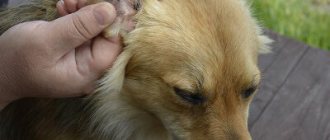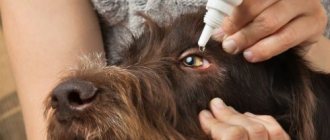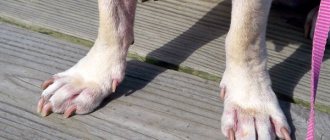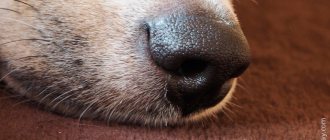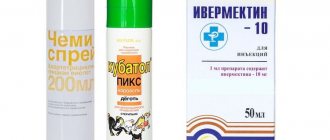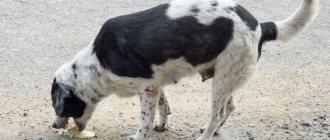Urgent gastric lavage for a dog at home
Dogs, like all people, do not have a stable body capable of independently rejecting anything; for this reason, cases of the development of dangerous diseases of various nature are not uncommon, but today we will talk about poisoning, which occurs quite often in pets, namely how to flush a dog's stomach. The fact is that in case of poisoning, it is very important to get rid of what caused it as quickly as possible, which is why it is important to know how to rinse a dog’s stomach at home, but not everything is always clear, let’s take a closer look at the various situations of poisoning, because rinsing is not always possible .
Foreign object in a dog and washing
In dogs with a foreign body, rinsing is usually not performed. Hairballs, as a rule, do not form in these animals, and serious foreign objects must be removed by a specialist in various ways - from classic instrumental extraction to surgical intervention.
If the swallowed object is small and does not have sharp edges, then help at home will consist of soldering the dog with various mineral oils (vaseline, for example), which will facilitate the rapid removal of the foreign body naturally through the rectum.
Due to the fact that the dog has a widened entrance to the pharynx, it can swallow anything. If an object gets stuck in the area of the pharynx and esophagus, the animal will begin to choke; if in the stomach and intestines, then signs of blockage in these parts of the gastrointestinal tract will appear after some time (from several hours to several days).
Indications for the rinsing procedure
It is worth mentioning that in dogs all poisonings are usually divided into sluggish and acute, but in both of these cases the stomach dissolves the poison in about one hour, the difference lies only in the further development. It’s very good if you immediately notice that your pet has swallowed some toxic substance, then you can start washing it right away, rather than waiting to see how the animal’s body will react to it. Here are the main symptoms of poisoning that can help identify the problem if you haven’t noticed that your pet has ingested anything poisonous:
- general weakness, as well as lethargic behavior;
- excessive salivation (if this has always been observed in a dog, then with poisoning this manifestation will simply intensify);
- blanching of the mucous membranes;
- refusal of any food, as well as (in some situations) drinking;
- nausea, gradually turning into vomiting;
- the appearance of pain in the abdominal cavity;
- changes associated with feces, namely changes in their smell and color;
- unnatural odor from the animal’s mouth;
- significant decrease in temperature;
- convulsions, most often localized in the hind limbs;
- in the most severe cases, the dog may lose consciousness or even fall into a coma.
Important! Such symptoms of intoxication in a dog’s body do not necessarily mean that you need to immediately find out how to flush a dog’s stomach, because the problem may lie in something else. For example, similar symptoms are very often observed when an animal’s body is affected by viral diseases, as well as bacteria. For this reason, it is best to immediately consult a specialist if possible!
Many experts confirm that gastric lavage for a dog is an effective and universal method for any poisoning, and it should be used to provide first aid to pets. It is worth mentioning that you don’t have to use it if you somehow manage to induce vomiting in the dog, but this can only be done in the first half hour, when everything has not yet been absorbed.
It is important to provide first aid, while talking on the phone with a veterinarian, describe to him all the changes that are currently happening to the pet, because even minor (in your opinion) changes can mean a lot.
When is it forbidden to flush a dog's stomach?
It is important that first aid makes the pet better, and does not harm it even more. The fact is that there are contraindications for gastric lavage, but first you should understand that, of course, you need to hurry, but do not neglect the examination! Be sure to sniff the dog's mouth and try to find anything that the pet might have drunk or eaten. Another well-known method is the use of milk or egg whites for poisoning, but in later stages these products will only harm your pet! Here are the main groups of poisons for which the stomach should not be washed:
Petroleum products. This group includes almost all petroleum products, for example, diesel fuel, gasoline, turpentine, kerosene, fuel oil, etc.
Acids and alkalis. These terms refer to household chemicals, most of which pose a serious danger to the dog. In this case, you can use milk as a sorbent, but you should immediately call a specialist so that he can quickly tell you how to provide first aid in this situation.
Medicines that are quickly absorbed and also have an effect on the animal’s nervous system (opiates, barbiturates).
In any of these three situations, your task will be to neutralize the poison, as well as induce vomiting. Here are the main steps:
Dissolve hydrogen peroxide in water, the required proportion is 1 to 1. Pour about 10 ml of this into the mouth (calculated per 1 kg of body weight). The action is based on the fact that contact with a solution of hydrogen peroxide will cause a reaction associated with increasing pressure in the stomach, and the vomiting process will begin. The dose should be different for each dog; if you can quickly contact a specialist, then do so.
The process of gastric lavage for a dog
As you might have guessed, this process can bring a lot of discomfort to the pet, so it is better to do the washing together with someone so that you can restrain the dog when necessary. Here is a list of things that may be useful to you in the process:
- Solution intended for washing. To do this, you can use pharmaceutical preparations, soda, manganese or table salt.
- Syringe.
- A large syringe, as well as a tube removed from the IV system. YOU can take any other similar device with which it will be convenient to pour liquid into the animal’s mouth.
- Absorbents. This often includes the simplest remedy - activated carbon; you can use any of its analogues.
- Laxatives.
- Substances intended to coat the walls of the stomach and intestines. Ask your doctor which ones are best to buy.
Here are the two most popular solutions with their preparation methods:
Saline solution . Take a teaspoon of ordinary table salt, then add 6-18 ml of solution depending on the animal’s body weight.
Potassium permanganate . Take a toothpick, dip it in potassium permanganate, and then into a glass of water. Start stirring until the liquid becomes smooth. Let the solution sit a little, then drain off the top layer. Only pale pink liquid should remain, and feed your pet with it.
Now try to induce vomiting, if problems arise, try to press on the walls of the stomach until the urge arises. In rare situations, if the urge was not caused in this way, wrap two fingers in a towel and then press on the root of your pet’s tongue.
Note! Under no circumstances should you hesitate if you find blood, feces or even bile in the remaining vomit. In this case, only a veterinarian can help the pet.
Gastric lavage in case of cat poisoning
The benefits of cleansing the stomach by lavage directly depend on how quickly appropriate measures were taken. The less time passes between poisoning and washing, the higher the effectiveness of the procedure. But you should also not refuse to wash it if a certain amount of time has passed - the poison may remain in the stomach, and its remains may cause suffering to the animal. Poisoning is manifested by vomiting, lethargy, refusal to eat (but thirst may remain), pallor of the mucous membranes, profuse salivation, coma, etc.
What to prepare for gastric lavage
- needleless syringe, syringe/rubber bulb;
- thin rubber tube;
- clean drinking water with a slightly pink solution of potassium permanganate (strictly without any remaining undissolved crystals);
- absorbent liquid for washing (0.5 l of clean drinking water + 4-5 tablets of activated carbon crushed into powder + 0.5 tsp of table salt + soda on the tip of a teaspoon);
- pieces of gauze or something else that can be used to bandage the paws;
- large terry towel.
Progress of the procedure
- secure the cat by tying its paws and wrapping it in a towel. The stomach should be rinsed only in cases when the cat is conscious!
- after fixation, insert a rubber tube under the tongue and begin pouring in a barely pink solution of potassium permanganate, then inducing vomiting by pressing on the root of the tongue (1-2 times);
- The total volume of liquid infused should not exceed 500 ml for an adult big cat, because when the volume is higher, the intestinal pylorus will reflexively open, and toxic substances will begin to enter the intestines;
- always look at the condition of the vomit - volume, color, consistency, etc.;
- after potassium permanganate, an absorbent liquid should be introduced into the stomach, which should be left in the stomach so that it acts for 10-15 minutes, and then induce vomiting;
- rinse the stomach until the liquid with vomit comes out relatively clean;
- be sure to monitor the body temperature - if the indicators decrease, you should immediately take the cat to the veterinarian;
- after washing, give the cat enterosgel - 0.5-1 tsp. gel per animal once a day (can be slightly diluted with water and injected with a syringe) or polysorb - 0.05-0.5 g/kg body weight (daily dose) diluted in water to obtain a liquid suspension (drink during the day );
- if the cat is unconscious, you can try to introduce liquid with adsorbents directly into the stomach through the esophagus from a position lying on its side: insert the tube until it feels free to pass into the stomach (if you blow into it, the abdominal cavity will noticeably swell), pour in the liquid and take the cat to a veterinarian.
Indications for gastric lavage
The dissolution of poisons in the stomach and their absorption occurs within an hour. It would seem that it was during this period that one could understand that something had happened to the dog. And if you also know what poisoned the animal, then, as a rule, there are no problems with providing first aid. However, poisoning can be not only acute, when all the symptoms are visible, but also sluggish.
Gastric lavage is more often required for puppies who want to try everything by tooth.
In case of poisoning, the following symptoms may occur:
- Lethargy and weakness.
- Paleness of the mucous membranes.
- Increased salivation.
- Refusal to eat, and sometimes even water.
- Diarrhea and vomiting.
- Strange smell and color of stool.
- Pain in the peritoneal area.
- Unpleasant odor from the mouth.
- Cramps.
- Decreased body temperature.
- Loss of consciousness.
Important. Similar symptoms can be caused by many bacterial and viral diseases. Therefore, it is important not to waste time and show the dog to the veterinarian.
If you know for sure that your dog has swallowed something poisonous, you need to immediately rinse his stomach. If you manage to do this in the first 20 minutes, then severe poisoning can be avoided. Although rinsing is also used at a later stage, the main thing is to act together with the veterinarian and listen to his advice.
What is needed for rinsing
Here's what we need to carry out the procedure at home:
- A syringe of sufficient capacity. We recommend using a Janet syringe, which you can buy at your nearest pharmacy. You can also use a rubber bulb (syringe) of sufficient capacity.
- Long, but soft and quite flexible tube. It is acceptable to use an IV, but you can look for tubes made of medical orange rubber. It contains an antiseptic, due to which the product has an easily recognizable, specific smell.
- Activated carbon.
How to flush a dog's stomach at home
Gastric lavage at home is not an easy task. Since even a puppy will resist this procedure, you need to find an assistant who will hold the animal while you carry out the necessary manipulations.
For rinsing you will need:
- A syringe (preferably large volume) or a syringe. You can also use another device (dropper tube, etc.) to pour liquid into the animal’s mouth.
- Water, table salt, potassium permanganate, soda or special preparations sold in pharmacies.
- Any absorbent - Atoxyl, activated carbon, etc.
- Drugs that coat the walls of the intestines and stomach. This could be Alumag, Maalox, etc.
- Laxatives.
Gastric lavage will cause the dog to vomit, releasing toxic substances.
After giving the dog salt, soda or other solution, you need to wait until it vomits. If the dog does not even have the strength to urge, it is worth helping him. To do this, gently press on the walls of the stomach, or wrap two fingers with a clean towel and press on the root of the dog’s tongue. The vomit should open. All the contents of the stomach must come out; you will understand this when the masses are transparent and watery. After this, give the animal an absorbent or laxative. After some time, you can give Maalox and similar drugs and drink strong tea.
Important. If you find blood, bile or feces in the vomit, you should not hesitate to visit a doctor. Washing and medications are powerless!
Preparing the rinsing solution
To rinse the stomach with potassium permanganate, you need to make a solution. To do this, wet the tip of a match with water and dip it into manganese crystals. Dip the match into the water and stir. Let the water sit for a while so that the undissolved crystals settle to the bottom. After this, pour the top layer of the solution into another container and dilute it to a light pink tint. The finished solution should not be deep red or have undissolved manganese crystals.
The salt solution is prepared at the rate of 1 teaspoon of salt per glass of water. The water should be warm, but boiled.
To rinse the dog's stomach, you can use a weak solution of potassium permanganate.
Having carried out all the necessary first aid measures at home, you still need to show the dog to the veterinarian. Some poisons can continue their negative effects, which only a specialist can cope with.
Lavage of a cat's stomach if a foreign object enters
Most often, foreign bodies blocking the stomach or intestines are hairballs. The cat may develop initial signs of intoxication: lethargy, lack of appetite, vomiting, during which nothing comes out.
With any foreign body in the stomach, you need to be sure that the object does not have sharp or cutting corners/sides and will not cause even more harm when it is washed out. If there is no such confidence, then it is forbidden to do anything on your own, but you should take your pet to the clinic.
What to cook to rinse a cat's stomach at home
- rubber bulb/syringe or needleless syringe;
- a thin rubber tube (suitable from a dropper), the cut edge of which is melted over a fire so as not to injure the cat’s esophagus;
- clean drinking water, to which you can add a special enveloping paste or absorbents;
- pieces of gauze;
- large thick towel.
How to rinse a cat's stomach
- protect your hands with long sleeves;
- bandage the cat's paws and wrap the animal tightly in a towel, lay it on its side;
- carefully place the tube under the tongue and begin pouring liquid into the mouth (for an adult, a maximum of up to 500 ml);
- when injecting half the dose, you should try to induce vomiting by pressing your finger on the root of the tongue. If there are no vomiting spasms, continue to infuse the liquid;
- try to provoke vomiting again, making sure that there are no obstacles for the release of vomit;
- as soon as the hairballs come out, you need to leave the cat alone, untying its paws and unwinding the towel;
- after 30-40 minutes, give the mustachioed pet milk or feed egg white as a coating agent. The procedure is over.
If vomiting begins with feces, you should immediately take the cat to the veterinary clinic, because This sign indicates a possible volvulus, which is deadly for the cat.
How to rinse a dog's stomach. Procedure and contraindications
Adult, trained dogs are less susceptible to poisoning than puppies, who strive to pick up and instantly swallow everything that seems more or less edible. In case of poisoning, you have 1–3 hours to rinse your dog’s stomach, which, you see, is not a long time. Among the “delicacies” may be tablets, household chemicals, fragments of painted paper (cardboard) or rotten food found on the street. An adult pet can be poisoned by rodent poisons by catching a pest or by contact chemicals by eating grass.
Gastric lavage technique
In order to rinse a dog’s stomach, you need to pour 150-250 ml of water into its mouth. The volume of liquid depends on the weight of the pet; the higher it is, the more water will be required.
For small dogs you can use a 20 ml syringe (without a needle), and for large animals - a children's enema bulb with a volume of 100-200 ml.
You need to rinse your stomach with plain water at room temperature. After pouring liquid into the pet’s mouth, you need to induce vomiting. If you are not afraid of the dog, press on the root of his tongue with your fingers. You can also sprinkle a pinch of salt on her tongue. Washing is considered effective when the dog is able to vomit.
Remember that using potassium permanganate on dogs is strictly prohibited. It can lead to severe intoxication and burns of the esophagus and stomach. There is no benefit from it.
Indications for gastric lavage in dogs
Poisoning is divided into acute and sluggish, however, in both cases, the stomach will take about an hour to dissolve and absorb the poison. You are lucky if you saw a dog swallow a potentially toxic substance - you know what you have to fight with and do not waste time on “experiments.” If an animal becomes ill for unexplained reasons, one or more of the following may be considered symptoms of poisoning:
- Weakness, lethargy.
- Drooling, pale mucous membranes.
- Ignoring food, sometimes drinking.
- Vomiting, diarrhea.
- Pain in the abdominal cavity.
- Unnatural color or smell of stool.
- Foreign odor from the mouth.
- Decreased body temperature.
- Weakness in the hind limbs, cramps.
- Loss of consciousness, coma.
In what cases is it contraindicated to rinse a dog’s stomach at home?
There are situations in which it is strictly forbidden to rinse an animal’s stomach, these include:
- vomiting black or red. In case of gastrointestinal bleeding, giving the animal something to drink or inducing vomiting is prohibited. By doing this you can increase blood loss;
- poisoning with acids or alkalis. With this type of intoxication, the stomach is cleansed through a tube by a veterinarian;
- disturbance of the animal's consciousness. If the dog is inhibited and reacts poorly to stimuli, it is dangerous to pour water into its mouth; it may choke.
Please note that the dog is not given a rinse if it is acting aggressively. If your pet growls and grins at you, you are afraid that he will bite you, do not risk your own health. Take him to the veterinary hospital.
Contraindications for gastric lavage in dogs
The first law of emergency care is do no harm, which happens quite often. If you don’t know what poisoned your dog, don’t panic and think. Try sniffing the mouth or fur around the mouth, and inspect the home for open containers with household chemicals. Milk, recommended always and everywhere, is not a “panacea”, just like egg white. If the lesion has affected the intestines or is a viral infection of the mucous membranes, dairy products will serve as a catalyst.
So, a dog should not have its stomach washed out if it is poisoned:
- Petroleum products – gasoline, diesel fuel, kerosene, fuel oil, turpentine.
- Acids and alkalis – almost all household chemicals. Milk is used as an absorbent.
- Rapidly absorbed medications that affect the functioning of the nervous system - barbiturates, opiates.
First of all, you need to neutralize the poison and induce vomiting without pouring a large amount of water into the stomach. Act quickly:
- Dissolve hydrogen peroxide in water in a 1:1 ratio. Pour into the mouth at the rate of 10–15 ml per 1 kg. As you know, peroxide foams upon contact with mucous membranes, the reaction will cause pressure in the stomach and vomiting. 5-10 ml is administered every 5-7 minutes until vomiting occurs.
- After the dog has vomited, the absorbents and substances that coat the stomach walls are removed.
- If there is no improvement within 20–30 minutes, you need to lavage the dog’s stomach and repeat step 3 and take the animal to the veterinarian.
Washing is contraindicated in case of convulsions, cardiac dysfunction, excessively weak condition (the dog is like a rag) and loss of consciousness. The best way out is to quickly take the dog to the doctor, rather than wait for help at home. Most likely, we are talking about poisoning with poisons, which are neutralized only with the introduction of an antidote.
Gastric lavage in the clinic and at home
In case of severe poisoning, you cannot risk the health of your four-legged friend; only veterinary specialists will provide effective assistance to the injured dog. Using special devices, doctors will lavage the stomach, give an enema, prescribe symptomatic treatment, and select a therapeutic diet during the dog’s recovery period. But sometimes circumstances arise when it is impossible to bring the injured pet to specialists; in this case, the procedure can be done at home.
How to perform gastric lavage on a dog? First, the animal must be immobilized. For large dogs, use a syringe; for small dogs, a 20 cc syringe without a needle is suitable. The procedure for cleansing the stomach can be carried out using 2 methods:
- Hydrogen peroxide is mixed with an equal amount of water and poured into the pet’s mouth (no more than 15 ml of solution per 1 kg of dog’s weight). Peroxide is administered in small portions every 5 minutes. The procedure is repeated until the animal is unable to induce vomiting. As soon as the vomit takes on a transparent appearance, the victim is given sorbents.
- Warm water with soda is taken into the container (the solution should be at room temperature). The liquid is poured into the mouth in small portions until the animal begins to vomit.
Gastric lavage is not performed on a dog if the animal has been poisoned by rat poison, otherwise the dog will develop internal bleeding and die.
In order to provoke vomiting, sometimes it is enough to pour a little salt on the tongue or press on the root with your fingers. But if the animal is aggressive, the dog’s stomach is pumped by a veterinarian.
Some dog owners use potassium permanganate to lavage the stomach, believing that this remedy will help cope with intoxication faster. The use of potassium permanganate by dogs is prohibited, as the substance can cause a burn to the stomach and esophagus, as well as intensify all existing symptoms.

